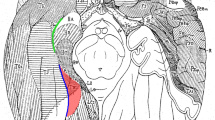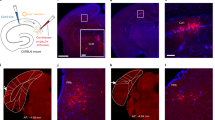The role of the posterior parahippocampal area of the brain in spatial types of memory in conditions of one-trial visual perception of the positions of objects was studied by training eight cats to remember the spatial positions of either two different objects covering two of three feeders placed on a test tray (tests for the “object–place” association) or the positions of two of three feeders (tests for place). Each trial used new objects and new positions for the two of three feeders. After training, four cats were subjected to electrolytic lesioning of the posterior parahippocampal area, primarily the parahippocampal cortex, parasubiculum, and presubiculum; the remaining four cats underwent all the surgical procedures except electrocoagulation of nervous tissue; this was the sham-operated control group. Cats of this group showed no impairment to the performance of tests of both types, while the experimental group showed similar levels of impairment to the performance of both tests. Thus, memory for one-trial perception of “object–place” associations and, more simply, two different object places in cats were critically dependent on the posterior parahippocampal area.
Similar content being viewed by others
References
K. N. Filimonov, Comparative Anatomy of the Cerebral Cortex in Mammals: the Paleocortex, the Archicortex, and the Diencaphalic Cortex [in Russian], Medgiz, Moscow (1949).
I. S. Beritashvili (Beritoff), Vertebrate Memory, its Characteristics and Origin, Plenum Press, New York (1971).
K. Brodmann, Vergleichende Localisationslehre der Grosshirnrinde in ihren Prinzipien dargestellt auf Grund des Zellenbaues, J. A. Barth, Leipzig (1909).
R. D. Burwell, “Borders and cytoarchitecture of the perirhinal and postrhinal cortices in the rat,” J. Comp. Neurol., 437, 17–41 (2001).
H. H. Jasper and C. Ajmone-Marsan, A Stereotaxic Atlas of the Diencephalon of the Cat, Ottawa, (1954).
J. Konorski, Integrative Activity of the Brain, University of Chicago Press, Chicago and London (1967).
L. Malkova and M. Mishkin, “One-trial memory for object-place associations after separate lesions of hippocampus and posterior parahippocampal region in the monkey,” J. Neurosci., 23, 1956–1965 (2003).
M. Mishkin, W. A. Suzuki, D. G. Gadian, and F. Vargha-Khadem, “Hierarchical organization of cognitive memory,” Phil. Trans. Roy. Soc. Lond. B. Biol. Sci., 352, 1461–1467 (1997).
E. A. Murray, “Medial temporal lobe structures contributing to recognition memory: The amygdaloid complex versus rhinal cortex”, in: The Amygdala: Neurobiological Aspects of Emotion, Memory and Mental Dysfunction, J. P. Aggleton (ed.),Wiley-Liss, London (1992), pp. 287–296.
E. A. Murray and T. I. Bussey, “Perceptual mnemonic functions of the perirhinal cortex,” Trends Cogn. Sci., 3, 142–151 (1999).
H. W. Nissen, A. H. Riesen, and V. Nowlis, “Delayed response and discrimination learning by chimpanzees,” J. Comp. Psychol., 26, 361–386 (1938).
V. Okujava, T. Natishvili, M. Mishkin, T. Gurashvili, S. Chipashvili, T. Bagashvili, G. Andronikashvili, and G. Kvernadze, “One-trial visual recognition in cats,” Acta Neurobiol. Exp., 65, 205–212 (2005).
D. S. Oltron, “Spatial memory,” Sci. Amer., 236, 82–98 (1977).
J. K. Parkinson, E. A. Murray, and M. Mishkin, “A selective mnemonic role for the hippocampus in monkeys: memory for the location of objects,” J. Neurosci., 8, 4159–4167 (1988).
F. Reinoso-Suarez, Topographischer Hirnatlas der Katze fur Experimental-Physiologische Untersuchungen, E. Merck, Darmstadt (1961).
L. R. Squire and S. Zola-Morgan, “The medial temporal lobe memory system,” Science, 253, 1380–1386 (1991).
M. P. Witter and H. J. Groenewegen, “Connections of the parahippocampal cortex in the cat. III. Cortical and thalamic efferents,” J. Comp. Neurol., 252, 1–31 (2004).
A. Woznicka and A. Kosmal, “Cytoarchitecture of the canine perirhinal and postrhinal cortex,” Acta Neurobiol. Exp., 63, 197–209 (2003).
S. Zola-Morgan, L. R. Squire, and N. L. Rasmus, “Severity of memory impairment in monkeys as function of locus and extent of damage within the medial temporal lobe memory system,” Hippocampus, 4, 483–495 (1994).
Author information
Authors and Affiliations
Corresponding author
Additional information
Translated from Zhurnal Vysshei Nervnoi Deyatel’nosti imeni I. P. Pavlova, Vol. 58, No. 3, pp. 331–338, May–June, 2008.
Rights and permissions
About this article
Cite this article
Okudzhava, V.M., Natishvili, T.A., Gurashvili, T.A. et al. Spatial Recognition in Cats: Effects of Parahippocampal Lesions. Neurosci Behav Physi 39, 613–618 (2009). https://doi.org/10.1007/s11055-009-9188-5
Received:
Accepted:
Published:
Issue Date:
DOI: https://doi.org/10.1007/s11055-009-9188-5




